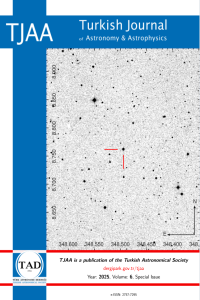Abstract
Bu çalışmada, Türkiye Ulusal Gözlemevleri bünyesindeki Doğu Anadolu Gözlemevi (DAG) optik laboratuvarında kurulan Shack-Hartmann adaptif optik (SH-AO) sisteminin düzeltme performansı deneysel olarak incelenmiştir. Çalışmanın giriş bölümünde, adaptif optik konseptine ve astronomik uygulamalardaki önemine genel bir bakış sunulmuş, ardından farklı türdeki dalga cephesi algılama tekniklerine değinilmiştir. Shack-Hartmann dalga cephesi sensörünün çalışma prensibi ve performans parametreleri detaylandırılmıştır. Materyal ve yöntem bölümünde, deneysel düzenek ve sistem bileşenleri hakkında bilgi verilmiş; mekanik kurulum ve hassas optik hizalama süreçleri ele alınmıştır. Optik yolda faz farkı oluşturabilecek statik ve dinamik aberasyon kaynaklarının sisteme entegrasyonu açıklanmıştır. Sonuçlar bölümünde, sistemin dalga cephesi düzeltme performansı değerlendirilmiştir. Elde edilen metrikler ve sonuçlar, sistem performansını analiz etmek amacıyla kullanılmıştır. Kalibrasyon sırasında kullanılan dalga cephesinin sahip olduğu, statik dalga cephesi hatası her iki durumda da ortak olarak bulunduğundan, bozulmuş ve düzeltilmiş dalga cephelerine ait tepe çukur hata ölçümleri kullanılarak yapılan hesaplama sonucunda, SH-AO sisteminin hata düzeltme yüzdesi %63.43 olarak hesaplanmıştır.
References
- Campbell, H.I., & A.H. Greenaway, “Wavefront sensing: From historical roots to the state-of-the-art.” EAS Publications Series, vol. 22, 2006, pp. 165–185, doi.org/10.1051/eas:2006131
- Dubra, A., “Wavefront sensor and wavefront corrector matching in adaptive optics”, Optics Express 15.6 (2007): 2762-2769.
- Babcock, Horace W., “The possibility of compensating astronomical seeing”, PASP, 65.386 (1953):229-236.
- Navarro, R., Justo A., and Ricardo, R., “Wavefront sensing with critical sampling”, Optics letters 36.4 (2011): 433-435.
- Zhu, Guchuan, et al., “Flatness-based control of electrostatically actuated MEMS with application to adaptive optics: a simulation study”, Journal of Microelectromechanical Systems 15.5 (2006): 1165-1174.
Abstract
This study experimentally investigates the wavefront correction performance of a Shack-Hartmann adaptive optics (SH-AO) system, established in the optics laboratory of the Eastern Anatolia Observatory (DAG), part of the Türkiye National Observatories. The introduction provides a comprehensive overview of the adaptive optics concept and its significance in astronomical applications. It is followed by a discussion of various wavefront sensing techniques. The operating principle and performance parameters of the Shack-Hartmann wavefront sensor are presented in detail. The materials and methods section describes the experimental setup and system components, including the mechanical assembly and precise optical alignment procedures. The integration of static and dynamic aberration sources, which introduce phase differences in the optical path, is explained. In the results section, the wavefront correction performance of the system is evaluated. The obtained metrics and results are utilized for the analysis of system performance. Given that the static wavefront error of the calibration wavefront was common to both cases, the SH-AO system's error correction percentage was calculated to be 63.43% based on the peak-to-valley error measurements of the distorted and corrected wavefronts.
References
- Campbell, H.I., & A.H. Greenaway, “Wavefront sensing: From historical roots to the state-of-the-art.” EAS Publications Series, vol. 22, 2006, pp. 165–185, doi.org/10.1051/eas:2006131
- Dubra, A., “Wavefront sensor and wavefront corrector matching in adaptive optics”, Optics Express 15.6 (2007): 2762-2769.
- Babcock, Horace W., “The possibility of compensating astronomical seeing”, PASP, 65.386 (1953):229-236.
- Navarro, R., Justo A., and Ricardo, R., “Wavefront sensing with critical sampling”, Optics letters 36.4 (2011): 433-435.
- Zhu, Guchuan, et al., “Flatness-based control of electrostatically actuated MEMS with application to adaptive optics: a simulation study”, Journal of Microelectromechanical Systems 15.5 (2006): 1165-1174.
Details
| Primary Language | Turkish |
|---|---|
| Subjects | Astronomical Sciences (Other) |
| Journal Section | Conference Paper |
| Authors | |
| Early Pub Date | June 22, 2025 |
| Publication Date | July 1, 2025 |
| Submission Date | December 5, 2024 |
| Acceptance Date | February 26, 2025 |
| Published in Issue | Year 2025 Volume: 6 Issue: Special Issue: UAK2024 Proceedings of the 23rd National Astronomy Congress |
TJAA is a publication of Turkish Astronomical Society (TAD).


